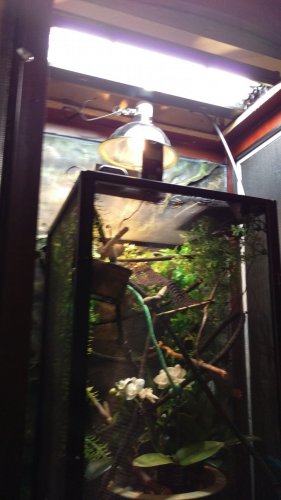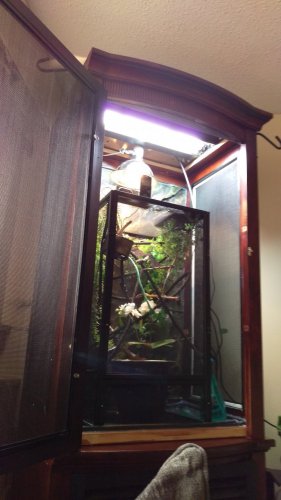I see a few posts and discussions below with much speculation on bulb UV strength and fixtures.
The fact is that the percentage of UV from the bulb is a GUIDE to use...
because
it is what actually gets in the cage that matters.
So...
I decided a diagram may explain this better.
You see, in a quad fixture, even though the fixtures can have very good polished reflectors, the bulbs beside the UV bulb act as "UV ABSORBERS" and do not reflect UV.
A 6% bulb in a single bulb parabolic fixture yields about as much UV into the environment as a 12% bulb in a quad fixture.
Also...
Over and over again I (and others) stress it is important to offer some shade or foliage so that the animal can get OUT OF THE UV IF THEY WANT TO.
But time and time again, I see picture after picture of these "Bare Top" cages.
What I mean is ...
these cages with a bunch of dense plants crammed down bottom WHERE THE ANIMALS SELDOM HANG OUT...
while up top where the animal is is all BARE with no plants, foliage or shade they can get into if they want to.
The "Light and Shade" method is the European method that works to duplicate Nature (REPEAT: Duplicate Nature) and create a more natural (ie. Better) environment that offers the animal choices just as it would get in the wild.
HERE is one fix--
Cut a piece of cardboard or something to shade a corner up top.
(Here is another fix: In the lights I sell, you can also cut a piece of the plexi and slide it back in the light to block UV but not light in an area to create UV gradients in the cage. I include instructions explaining that. I have the only product that does this!)
Also, the screen on a cage automatically cuts down the UV by 25-40%.
Now, if someone wanted to also create a UV gradient, they could add a piece of screen under the light at one end ... say 1/3... and in effect have 2 layers of screen in an area so the animals have a choice in the strength of UV they want to sit in.
An 18 x 18 x 36 cage makes it hard to create any decent UV gradients in it because it is small.
Folks tend to speculate around and around and around on UV and the strength of bulbs ...
But...
The ONLY REAL WAY TO TELL if you have the right UV and it is on target in your cage environment is with a Solarmeter.
It is a good idea to invest in one.
The 6.2 is ok.
The 6.5 is a bit better because it focuses on the narrower band of UV that pertains to Vitamin D synthesis.
But both work well because you can establish a baseline of what your UV is, and that is key.
Now,
because retailers make so little or no money on Solarmeters, (and they are so expensive to stock) they do not always like to carry them.(*e-hem*)......especially since you can buy them direct from Solarmeter anyway.
Here ya go:
https://www.solarmeter.com/model65.html?utm_source=google&utm_medium=cpc&utm_content=6.5UVIndex
Here is the info I include with the double bulb and quad fixtures.
HINT:
Remember, you can use a piece of glass or plexi to block UV to create a low/ no UV zone in your cage.
Because glass & plexi is clear and transmits visible light but not UV--
You can create this low UV / No UV zone *without* darkening your cage or sacrificing visible light for your plants.
**This little trick will work with ANY kind of fixture and UV bulb**
Anyway, this is the blub that is in my Double Bulb and Quad Fixtures:
"IMPORTANT
Slide out the plastic lens that protects the bulbs in shipment and Do Not Use It. It will block approx. 95% of the UV rays.
You may want to keep bottom of fixture open so all heat and UV can escape.
NOTE:
In certain situations, depending on your cage set up and the type of reptiles or amphibians in it, you may want to cut a 1/4 or 1/3 piece of it and slide it back in. Then simply position it to one end or the other on the fixture. It will block UV in that area to create a Low/ No UV Zone. (It cuts easily with a sharp utility knife. Simply score deeply and snap it, then peel off protective opaque plastic film.)
Remember: It is always a good idea to check UV levels regularly with a Solarmeter if you have access to one.
Thank you! Todd Goode"
~~~~~~~~~~~~~~~~~~~~~~~~~~~~~~~~~~~~~~~~~~~~~~~~~~~~~~~~~~
Also:
Arcadia bulbs last at LEAST a year.
Many last UP TO 2 YEARS in acceptable UV out-put.
That is why even though they cost more...
YOU SAVE MONEY and the environment by generating less mercury infused waste.
(All flo. bulbs contain mercury.)
However,
if you do not have a Solarmeter to check for sure, play it safe and replace every 12 mo.
Hope all this helps on a Saturday afternoon.
Cheers
Todd
www.lightyourreptiles.com

##########################################################################
Now...
factor in a screen under the above lights and you are knocking the UV down about by another third (25% - 42%) ...
so you see why in a quad fixture, a 12% bulb can be used over well planted (ie: cages with USE-ABLE SHADE) set ups.
In single bulb fixtures, stick to a 6% Arcadia bulb.
No matter what light or bulb strength, always provide USE-ABLE SHADE up near the top of the cage they can easily retire into if they want to.
The fact is that the percentage of UV from the bulb is a GUIDE to use...
because
it is what actually gets in the cage that matters.
So...
I decided a diagram may explain this better.
You see, in a quad fixture, even though the fixtures can have very good polished reflectors, the bulbs beside the UV bulb act as "UV ABSORBERS" and do not reflect UV.
A 6% bulb in a single bulb parabolic fixture yields about as much UV into the environment as a 12% bulb in a quad fixture.
Also...
Over and over again I (and others) stress it is important to offer some shade or foliage so that the animal can get OUT OF THE UV IF THEY WANT TO.
But time and time again, I see picture after picture of these "Bare Top" cages.
What I mean is ...
these cages with a bunch of dense plants crammed down bottom WHERE THE ANIMALS SELDOM HANG OUT...
while up top where the animal is is all BARE with no plants, foliage or shade they can get into if they want to.
The "Light and Shade" method is the European method that works to duplicate Nature (REPEAT: Duplicate Nature) and create a more natural (ie. Better) environment that offers the animal choices just as it would get in the wild.
HERE is one fix--
Cut a piece of cardboard or something to shade a corner up top.
(Here is another fix: In the lights I sell, you can also cut a piece of the plexi and slide it back in the light to block UV but not light in an area to create UV gradients in the cage. I include instructions explaining that. I have the only product that does this!)
Also, the screen on a cage automatically cuts down the UV by 25-40%.
Now, if someone wanted to also create a UV gradient, they could add a piece of screen under the light at one end ... say 1/3... and in effect have 2 layers of screen in an area so the animals have a choice in the strength of UV they want to sit in.
An 18 x 18 x 36 cage makes it hard to create any decent UV gradients in it because it is small.
Folks tend to speculate around and around and around on UV and the strength of bulbs ...
But...
The ONLY REAL WAY TO TELL if you have the right UV and it is on target in your cage environment is with a Solarmeter.
It is a good idea to invest in one.
The 6.2 is ok.
The 6.5 is a bit better because it focuses on the narrower band of UV that pertains to Vitamin D synthesis.
But both work well because you can establish a baseline of what your UV is, and that is key.
Now,
because retailers make so little or no money on Solarmeters, (and they are so expensive to stock) they do not always like to carry them.(*e-hem*)......especially since you can buy them direct from Solarmeter anyway.
Here ya go:
https://www.solarmeter.com/model65.html?utm_source=google&utm_medium=cpc&utm_content=6.5UVIndex
Here is the info I include with the double bulb and quad fixtures.
HINT:
Remember, you can use a piece of glass or plexi to block UV to create a low/ no UV zone in your cage.
Because glass & plexi is clear and transmits visible light but not UV--
You can create this low UV / No UV zone *without* darkening your cage or sacrificing visible light for your plants.
**This little trick will work with ANY kind of fixture and UV bulb**
Anyway, this is the blub that is in my Double Bulb and Quad Fixtures:
"IMPORTANT
Slide out the plastic lens that protects the bulbs in shipment and Do Not Use It. It will block approx. 95% of the UV rays.
You may want to keep bottom of fixture open so all heat and UV can escape.
NOTE:
In certain situations, depending on your cage set up and the type of reptiles or amphibians in it, you may want to cut a 1/4 or 1/3 piece of it and slide it back in. Then simply position it to one end or the other on the fixture. It will block UV in that area to create a Low/ No UV Zone. (It cuts easily with a sharp utility knife. Simply score deeply and snap it, then peel off protective opaque plastic film.)
Remember: It is always a good idea to check UV levels regularly with a Solarmeter if you have access to one.
Thank you! Todd Goode"
~~~~~~~~~~~~~~~~~~~~~~~~~~~~~~~~~~~~~~~~~~~~~~~~~~~~~~~~~~
Also:
Arcadia bulbs last at LEAST a year.
Many last UP TO 2 YEARS in acceptable UV out-put.
That is why even though they cost more...
YOU SAVE MONEY and the environment by generating less mercury infused waste.
(All flo. bulbs contain mercury.)
However,
if you do not have a Solarmeter to check for sure, play it safe and replace every 12 mo.
Hope all this helps on a Saturday afternoon.
Cheers
Todd
www.lightyourreptiles.com
##########################################################################
Now...
factor in a screen under the above lights and you are knocking the UV down about by another third (25% - 42%) ...
so you see why in a quad fixture, a 12% bulb can be used over well planted (ie: cages with USE-ABLE SHADE) set ups.
In single bulb fixtures, stick to a 6% Arcadia bulb.
No matter what light or bulb strength, always provide USE-ABLE SHADE up near the top of the cage they can easily retire into if they want to.
Last edited:





